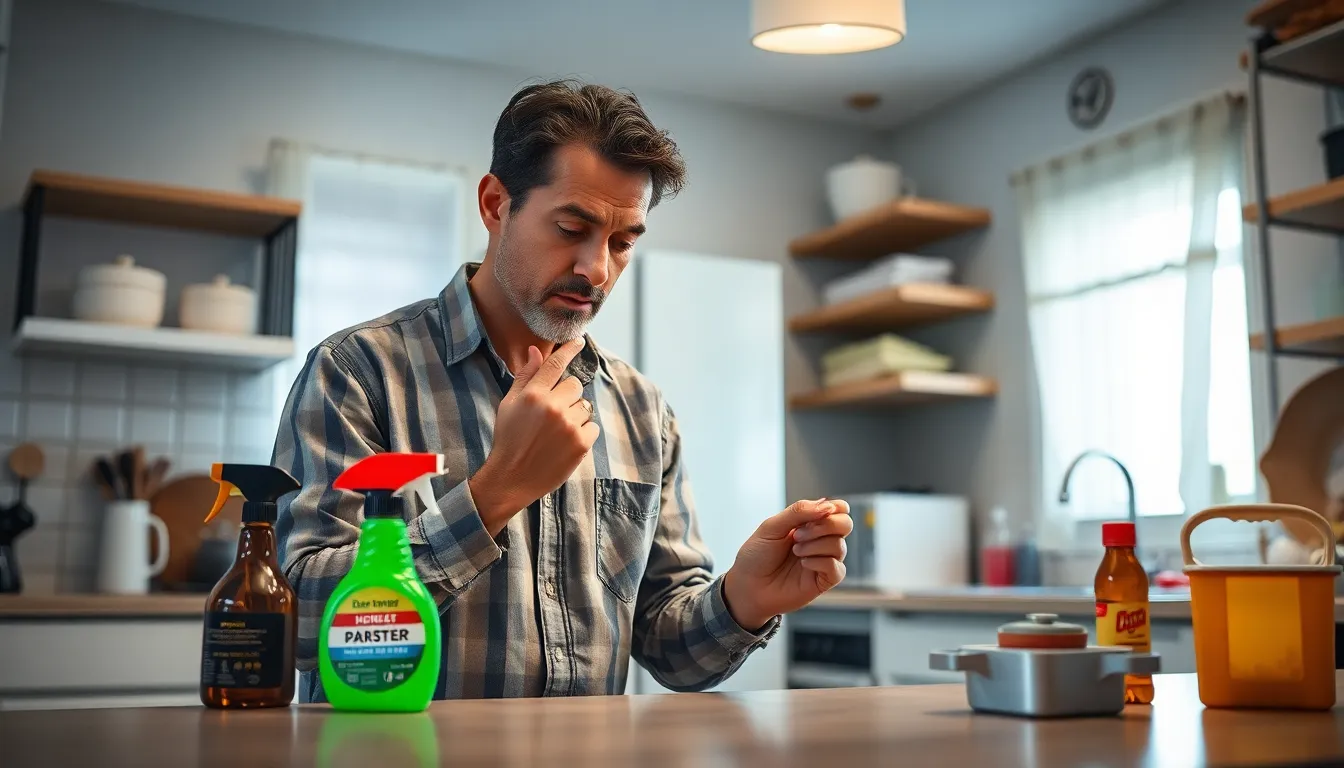Bugs are the uninvited guests nobody wants at their home party. They sneak in, make themselves comfortable, and before you know it, your living room’s turned into a bug convention. From ants marching in formation to cockroaches performing acrobatics, these critters can turn a cozy space into a nightmare faster than you can say “pest control.”
Table of Contents
ToggleOverview of Bug Control
Bug control aims to eliminate and manage pests that invade residential spaces. Many homeowners face challenges with insects like ants, cockroaches, and termites. Effective control methods reduce these pests’ populations and prevent future infestations.
Integrated Pest Management (IPM) plays a crucial role in bug control. IPM combines multiple strategies, including biological, physical, and chemical methods. This approach targets specific pests while minimizing impacts on the environment and non-target organisms.
Utilizing pest control products involves selecting the appropriate chemicals. Choosing pesticides that specifically target the pests in question leads to more effective results. Learning to read labels ensures correct application rates and safety precautions.
Regular inspections also contribute to successful bug control. Identifying pest entry points can reduce the likelihood of infestations. Homeowners should look for cracks, gaps, and damp areas that provide shelter or access for bugs.
Cultural practices further enhance pest management efforts. Maintaining a clean and clutter-free environment discourages pests from settling in. Store food in airtight containers and dispose of waste promptly to eliminate food sources.
Understanding the life cycle of pests assists in forming effective control strategies. For instance, targeting egg stages can prevent populations from growing. Knowing when pests are most active helps to determine optimal treatment times.
Engaging professional pest control services offers an extra layer of protection. Experienced technicians can provide tailored solutions based on specific pest issues. They also offer long-term monitoring and maintenance plans to keep homes bug-free.
Importance of Bug Control

Effective bug control plays a crucial role in maintaining a safe and healthy living environment. Addressing pest issues promptly prevents further complications, ensuring peace of mind for homeowners.
Health Risks Associated with Pests
Pests often carry diseases that can affect human health. For instance, cockroaches may trigger asthma and allergies, while rodents can transmit hantavirus and leptospirosis. Insects like ticks and mosquitoes pose significant risks by spreading Lyme disease and West Nile virus. It’s essential to recognize and mitigate these health threats through comprehensive pest control strategies. Regular inspections and immediate action against infestations protect family members from potential illness.
Economic Impact of Pest Infestations
Pest infestations can lead to substantial financial losses. Termites alone cause approximately $5 billion in damage annually in the United States. Homeowners may incur costs for repairs, pest control services, and replacement of contaminated food items. Businesses also suffer, facing losses due to damaged products and decreased customer trust. Implementing effective control measures not only safeguards homes but also preserves property value and promotes economic stability.
Types of Bug Control Methods
Various methods exist for effective bug control. Each method targets specific pests and addresses different aspects of the pest management process.
Chemical Control
Chemical control utilizes pesticides to eliminate pests. These products often contain active ingredients designed to target the biology of insects. Commonly used chemicals include pyrethroids and insect growth regulators. Application is crucial; homeowners must ensure proper usage to avoid harm to non-target species. Regular monitoring can help determine the effectiveness of the treatment. Selecting the right product for specific situations enhances the success rate of pest management efforts.
Biological Control
Biological control employs natural predators or pathogens to manage pest populations. Beneficial insects, such as ladybugs and parasitic wasps, contribute significantly by preying on pest species. This method minimizes reliance on synthetic chemicals and promotes ecological balance. For instance, introducing nematodes can effectively manage larvae in soil. By harnessing nature’s existing relationships, biological control fosters a sustainable approach to pest management.
Cultural Control
Cultural control encompasses practices that create an environment unsuitable for pests. Maintaining cleanliness and proper waste management deters insect infestations. Regularly inspecting plants and managing irrigation reduces moisture levels that attract pests. Crop rotation in agriculture disrupts pest life cycles, minimizing their survival rates. Adopting these practices enhances overall pest resistance and promotes healthier living environments.
Mechanical Control
Mechanical control involves physical barriers and traps to manage pests. Methods such as sealing entry points prevent access for insects. Sticky traps capture flying insects, while vacuuming removes pests directly from surfaces. Installing screens on windows and doors decreases intrusion. By applying these techniques, homeowners can effectively reduce pest populations without relying solely on chemicals. Combination strategies often yield the best results in pest management.
Integrated Pest Management (IPM)
Integrated Pest Management (IPM) employs multiple strategies to control pests while minimizing environmental impact. This approach focuses on prevention by combining biological, physical, and chemical methods in a cohesive plan. Homeowners benefit from IPM techniques as they involve ongoing monitoring and assessment of pest populations.
Biological control uses natural predators, such as ladybugs for aphids or nematodes for soil pests, to keep infestations in check. Physical methods might include sealing entry points and installing barriers to prevent pests from accessing homes. Chemical strategies employ targeted pesticides, ensuring they address specific pest issues without harming beneficial organisms.
Regular inspections play a critical role in IPM, allowing homeowners to identify potential entry points or signs of infestations early. Maintaining a clean environment also deters pests. Clutter and food residues attract bugs like ants and cockroaches, making cleanliness a priority in pest management efforts.
IPM emphasizes education and awareness about the life cycles of common pests. Understanding specific behaviors and vulnerabilities helps in formulating effective control measures. Engaging professional pest control services provides further insights for tailored strategies, ensuring long-term monitoring and maintenance of a pest-free home.
Cost-effectiveness is another advantage of IPM. By addressing pest issues proactively, homeowners can reduce the likelihood of expensive repairs and long-term damage caused by infestations. Municipalities and businesses also benefit from IPM strategies, promoting healthier environments and minimizing economic losses related to pest problems.
Choosing the Right Bug Control Method
Selecting an effective bug control method requires careful evaluation of various factors. Several pest control options exist, so understanding specific needs is essential for homeowners.
Factors to Consider
Initial considerations include the type of pest present. Ants, cockroaches, and termites differ in behavior and habitat, requiring tailored approaches. Another factor is the severity of the infestation; small populations may need simple remedies, while larger issues might necessitate advanced techniques. Homeowners must also evaluate the safety of chosen products, especially in homes with children and pets. Environmental impact matters too, making Integrated Pest Management a popular choice. Effectiveness of treatment options should reflect the ultimate goal of long-term pest prevention, which often means focusing on cleanliness and regular maintenance.
Benefits of Professional Assistance
Engaging professional pest control services offers notable advantages. Experts possess specialized knowledge about pest behavior, allowing them to identify root causes of infestations. Customization of treatment plans ensures strategies address specific situations effectively. Professionals also have access to advanced tools and products that aren’t available to homeowners. Time savings arise when experts efficiently manage pest issues without ongoing homeowner involvement. Furthermore, long-term monitoring provides peace of mind, reducing the risk of future infestations. This comprehensive approach supports maintaining a healthier living environment and minimizes economic losses associated with unchecked pest problems.
Effective bug control is essential for maintaining a safe and healthy living environment. Homeowners must take proactive measures to prevent infestations and address any pest issues swiftly. By understanding the specific challenges posed by various pests and utilizing Integrated Pest Management strategies, individuals can minimize health risks and economic losses.
Engaging professional pest control services offers tailored solutions and expert guidance, ensuring long-term success in managing pest problems. Ultimately, prioritizing bug control not only enhances comfort at home but also protects the overall well-being of residents and their property.


